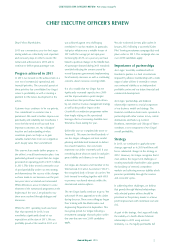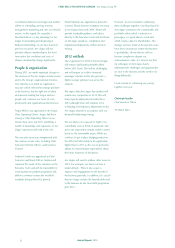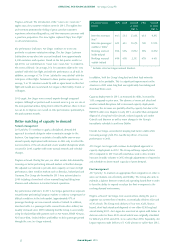Aer Lingus 2011 Annual Report Download - page 16
Download and view the complete annual report
Please find page 16 of the 2011 Aer Lingus annual report below. You can navigate through the pages in the report by either clicking on the pages listed below, or by using the keyword search tool below to find specific information within the annual report.
Annual Report 2011
OPERATING AND FINANCIAL REVIEW Aer Lingus Group Plc
Please note that the 2010 comparatives have been restated following a
voluntary change in accounting policy adopted during 2011 and
applied retrospectively related to IAS 19 “employee benefits”.
Following the change, actuarial gains and losses associated with post
employment benefit obligations are recognised in the statement of
comprehensive income rather than the income statement. The
previously reported operating profit, before exceptional items, was
¤57.6 million for full year 2010.
Introduction
In 2011, Aer Lingus continued to follow the same strategic path which
it pursued in 2010 with no significant change in the fundamental
measures being implemented. The Group’s capacity plan remained
stable compared to 2010, when adjusted for the non-recurrence of ash
cloud and severe weather disruption in 2010.
Aer Lingus reported an operating profit, before net exceptional items,
of ¤49.1 million (2010: profit of ¤52.5 million) for 2011. However, the
Group recorded a net profit before tax for the year of ¤84.4 million
(2010: profit of ¤27.2 million). This increased pre-tax profit was due to
exceptional items, which comprised a ¤37.2 million credit in 2011
compared with a ¤31.0 million charge in 2010.
Passenger revenue
Passenger revenue for the year was 6.7% ahead of 2010 at ¤1,068.0
million (2010: ¤1,001.1 million), with passenger numbers increasing by
1.8% to 9.51m (2010: 9.34m). Average fare per passenger increased
by 4.8% to ¤112.27 (2010: ¤107.12). Total passenger load factor
decreased by 0.5 points to 75.6%.
Aer Lingus previously estimated that 5.6% of planned capacity was lost
in 2010 due to the impact of ash cloud and weather related
disruption. The Group increased capacity deployment by 1.8% in
2011. This increase reflects the non-recurrence of ash and weather
disruption in 2011 partly offset by lost capacity attributable to the
IMPACT cabin crew dispute in January and February 2011, a reduction
in some winter flying in 2011 and the earlier than originally targeted
sale of an A330 aircraft which also affected annual capacity levels.
Short haul
Total short haul passengers carried in 2011 increased by 2.1% to
8,616,000 and average short haul yield increased by 5.5% or ¤4.73 to
¤90.65 (2010: ¤85.92). Short haul fare revenue was ¤781.0 million,
(2010: ¤725.0 million), an increase of 7.7%.
Short haul capacity, measured by ASKs increased by 2.6%. This was
because there was no repeat of the closure of Northern European
airspace in H1 2011 compared with 2010 or the weather related
disruptions in January, November and December 2010. However, this
increased capacity was offset by reduced capacity at London Gatwick
in Q1 2011 and the effect of the IMPACT cabin crew dispute.
Capacity utilisation, measured by revenue passenger kilometres (RPKs),
increased by 2.2% resulting in short haul load factor decreasing by 0.3
points to 74.6%. This decline reflects a number of factors including
continuing weakness on certain leisure routes partly offset by strong
performances on key time sensitive markets where Aer Lingus has
focused on serving increasing passenger demand.
In general, time sensitive and business oriented routes performed well
in 2011. Passenger revenues from services to Germany, France,
Benelux and Switzerland increased on a year-on-year basis. These
performances helped support weaker year-on-year revenue
development on routes to markets such as Spain, Portugal and some
Central European destinations.
Short haul yields in 2011 increased by 5.5% over 2010. This positive
result was not driven by simplistic fare increases but rather reflects a
more sophisticated approach to yield management. This approach
includes the deliberate re-positioning of Aer Lingus to serve performing
European passenger markets, exposure to a higher yielding
multichannel distribution strategy and as explained earlier, the re-
definition of our product offering to now focus explicitly on different
market segments.
During the first half of 2011, three older A321 aircraft were retired
from the short haul fleet and returned to their lessors. Four new A320
aircraft were acquired on finance leases. The Group also intends to
introduce two leased A319 aircraft in early 2012 to replace operating
leased A320 aircraft exiting the fleet. The economics associated with
the A319 aircraft type are appropriate
for some of the lower demand
routes within the Aer Lingus network and should drive further
operating and cost efficiencies. Aer Lingus has no current plans to
significantly change short haul capacity deployment in 2012.
Long haul
Aer Lingus implemented significant changes to its long haul network in
late 2009 with the objective of restoring this important part of the
Group’s business to profitability. Total long haul passengers decreased
by 1.2% to 897,000. However, average long haul yield increased by
5.2% or ¤15.89 to ¤319.96 (2010: ¤304.07) in 2011. This was due in
part to higher business class occupancy.
In 2011, approximately 21% of long haul passenger revenues
represented inter-connecting passengers from other airlines with whom
Aer Lingus has inter-line agreements.
2011 FINANCIAL REVIEW
14
























